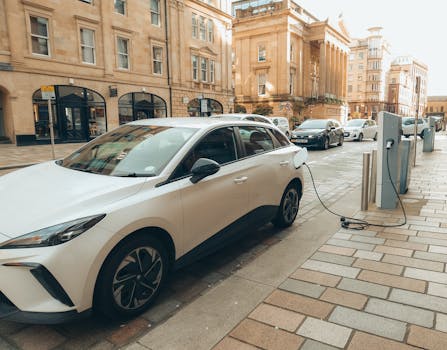
**
Electric vehicles (EVs) are no longer a niche market; they're rapidly becoming mainstream. Recent data reveals a staggering increase in EV adoption, with market share nearly doubling in many regions across the globe. This explosive growth is driven by a confluence of factors, including falling battery prices, expanding charging infrastructure, increasingly stringent emission regulations, and a growing consumer awareness of environmental concerns. This article delves into the key drivers behind this electrifying transformation and explores what the future holds for the automotive industry.
The Electrifying Rise of Electric Cars: A Global Phenomenon
The automotive landscape is undergoing a dramatic shift, with electric cars leading the charge. The increased adoption isn't limited to a single country; it's a global trend. From the bustling streets of European capitals to the sprawling highways of North America and the rapidly developing markets of Asia, electric vehicles are making their mark. This phenomenal growth signals a significant turning point in the fight against climate change and a revolution in personal transportation.
Key Factors Driving EV Market Share Growth:
Several interconnected factors have fueled the rapid expansion of the EV market. These include:
Decreasing Battery Costs: The cost of lithium-ion batteries, a crucial component of EVs, has plummeted in recent years. This reduction in manufacturing costs has made EVs increasingly affordable, bringing them within reach of a broader consumer base. This cost reduction directly impacts the overall price of electric cars, making them more competitive with gasoline-powered vehicles.
Government Incentives and Subsidies: Many governments worldwide are implementing generous incentives, such as tax credits, rebates, and subsidies, to encourage EV adoption. These financial incentives significantly reduce the upfront cost of purchasing an electric car, making them a more attractive option for consumers. Examples include the US Clean Vehicle Tax Credit and various EV purchase schemes in Europe.
Expanding Charging Infrastructure: The growth of public charging stations is another critical factor driving EV adoption. The availability of convenient and reliable charging infrastructure reduces range anxiety – a major concern for potential EV buyers. Fast-charging networks are also expanding rapidly, further alleviating range concerns. This development is particularly important for long-distance travel.
Improved Battery Technology and Range: Advances in battery technology have led to significant improvements in EV range. Modern electric cars can now travel considerably further on a single charge, addressing one of the primary drawbacks of earlier EV models. This extended range greatly enhances the practicality and appeal of EVs for everyday use.
Stringent Emission Regulations: Governments are increasingly implementing stricter emission standards to combat air pollution and climate change. These regulations often favor electric vehicles, making them a more attractive option for automakers. This regulatory push accelerates the transition to cleaner transportation options.
Growing Environmental Awareness: Consumers are becoming increasingly aware of the environmental impact of gasoline-powered vehicles. The desire for sustainable transportation options is driving demand for electric cars, contributing to their rising market share.
The Future of Electric Vehicles: Challenges and Opportunities
Despite the remarkable progress, the widespread adoption of electric vehicles still faces some challenges:
Charging Infrastructure Gaps: While charging infrastructure is expanding, there are still significant gaps, particularly in rural areas and less developed regions. Addressing this infrastructure deficit is crucial for ensuring equitable access to EVs.
Electricity Grid Capacity: The increased demand for electricity from EV charging could strain existing power grids. Investing in grid modernization and renewable energy sources is necessary to support the widespread adoption of EVs.
Raw Material Supply Chains: The production of EV batteries relies on several raw materials, some of which have limited availability. Securing sustainable and ethical sourcing of these materials is essential for the long-term growth of the EV industry. This includes responsible mining practices and the development of alternative battery technologies.
Battery Recycling: As more EVs reach the end of their lifespan, effective battery recycling programs are vital to minimize environmental impact and recover valuable materials.
Opportunities in the EV Market:
Despite the challenges, the future of the electric vehicle market is bright. The opportunities are vast, including:
Innovation in Battery Technology: Continued research and development in battery technology promises even greater energy density, longer range, and faster charging times. Solid-state batteries and other advanced technologies are expected to revolutionize EV performance.
Autonomous Driving Integration: The integration of autonomous driving technology with electric vehicles has the potential to further enhance their appeal and transform the transportation landscape.
Growth of the EV Charging Ecosystem: The expansion of charging infrastructure, including smart charging solutions and vehicle-to-grid (V2G) technology, will further enhance EV usability and grid stability.
Conclusion: The Road Ahead for Electric Cars
The rapid growth of the electric vehicle market signifies a major shift in the automotive industry and a crucial step towards a more sustainable future. While challenges remain, the positive momentum is undeniable. Continued investment in battery technology, charging infrastructure, and supportive government policies will be key to accelerating the transition to a world powered by electric vehicles. The future of transportation is electric, and the road ahead is paved with innovation and opportunity. The rise of electric cars is not just a trend; it’s a revolution that is reshaping our world.




















